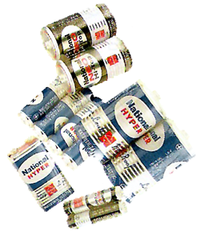
Photo from wikipedia
Silicon-core carbon-shell nanoparticles have been widely studied as promising candidates for the replacement of graphite in commercial lithium-ion batteries. Over more than 10 years of R&D, the many groups actively… Click to show full abstract
Silicon-core carbon-shell nanoparticles have been widely studied as promising candidates for the replacement of graphite in commercial lithium-ion batteries. Over more than 10 years of R&D, the many groups actively working in this field have proposed a profusion of distinctive nanomaterial designs. This broad variety makes it extremely challenging to establish mechanistic insight into how fundamental material structure and properties affect battery performance. In particular, the interplay between the character of the carbon encapsulation layer and the electrochemical performance of the composite is still poorly understood. In this work, we aim to address this lack of knowledge through the development of a modified chemical vapor deposition approach that enables precise control of the degree of graphitization of the carbon coating. We provide a comparison between core-shell structures maintaining identical silicon cores with different types of carbon shells, i.e. graphitic carbon and amorphous carbon. A highly graphitic carbon layer is not only characterized by higher electrical conductivity but markedly favors the transport of lithium ions into the silicon core with respect to an amorphous one. This advantageous property confers better cycling stability to the composite material. We also demonstrate that the graphitic-carbon-coated particles display excellent electrochemical performance even when used as a simple "drop-in" additive in graphite-dominant anodes for current generation Li-ion batteries. Replacement of 10% by weight of graphite in the electrode composition results in an increase of 60% in the storage capacity, with a first cycle Coulombic efficiency of 91% and capacity retention over 100 cycles of 81%.
Journal Title: Nano letters
Year Published: 2019
Link to full text (if available)
Share on Social Media: Sign Up to like & get
recommendations!